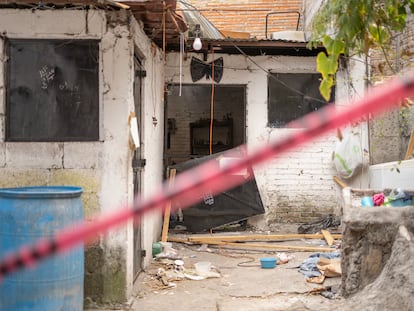Wave of mass kidnappings puts Mexican state of Nuevo León on alert
In one month at least 42 people have gone missing in the northeastern state. Seven remain unaccounted for. The latest episode, the disappearance of 12 construction workers, demonstrates the power of organized crime
The Mexican state of Nuevo León is experiencing a wave of mass disappearances. In just one month, at least 42 people have been collectively kidnapped in three parts of the northeastern state. Most have since been released, but seven remain unaccounted for, according to the State Prosecutor’s Office. The towns of Ciénega de las Flores, Salinas Victoria, and Anáhuac have become the three points of a criminal triangle. The latest episode was the kidnapping of 12 construction workers and their release a few hours later on Monday, illustrating the failure of state authorities to contain criminal groups that operate with impunity in the territory.
In the early hours of Sunday, 12 bricklayers were kidnapped in Anáhuac, a small municipality near Texas, on the border with the United States. They were taken at night and returned about 24 hours later, after media coverage and a search operation. The first of the group to be located was a 17-year-old boy who was found in Nuevo Laredo, in the state of Tamaulipas, about 40 miles from the spot where he was kidnapped. The other 11 workers were released early this Monday at undisclosed locations. “All of them are in apparent good health,” the Nuevo León Prosecutor’s Office told EL PAÍS.
Meanwile Humberto Villarreal, a 21-year-old student who had been kidnapped on March 21 in Ciénega de las Flores, was rescued five days ago In Anáhuac. There are 124 miles between both municipalities. Villarreal was taken from his house at 2 a.m. according to statements by his aunt, Marisol Sánchez, to the newspaper Milenio. The kidnappers broke the door of the house with axes and took him away in his underwear, after threatening the rest of the family: “They threatened me and said not to file a complaint, otherwise they were going to return him to me in pieces.” The woman says that she called the police at the time of the attack, but that they never arrived. That same day, a woman also disappeared in Ciénega, who has not yet been located.
On the night of March 23, again in Ciénega de las Flores, 13 people were kidnapped, including six children. The minors and one adult were released on March 31. One of them said he had been held with Humberto Villareal, which provided clues that the young man was still alive. Six of those people, four men and two women, remain unaccounted for.
On March 27, another 13 people, members of four different families, were kidnapped in Salinas Victoria, the municipality next to Ciénega. Among them, there were again six minors. The Ministry of Defense reported their release on April 1. In the statement, the federal agency announced that in addition to those 13 individuals, they had released three other people from the municipality who had been in the hands of a criminal group for more than 20 days. “All this is happening before the eyes of the authorities,” says Angélica Orozco, a member of the collective Fuerza Unida por Nuestros Desaparecidos en Nuevo León (United Force for Our Disappeared Ones in Nuevo León).
It is not the first time that Nuevo León has suffered a spate of abductions. There are 6,722 missing people in the state, the fifth-highest number in Mexico after Jalisco (15,000), Tamaulipas (13,170), State of Mexico (12,380) and Veracruz (6,885). One of the last crises took place two years ago with the disappearance of young women on the outskirts of Monterrey: María Fernanda, Debanhi, and Yolanda were found dead. A little earlier, between August and November 2021, it was in Sabinas Hidalgo, where criminal groups took 11 girls; only two have been located, also dead. Also in 2021, on the road from Monterrey to Nuevo Laredo, on the so-called “highway of death,” more than 100 people went missing on a stretch of just 124 miles. At that time, authorities pointed out that the kidnappings were a way to control the territory by a criminal group trying to search for their opponents. This dynamic may be repeating itself now.
“Collective disappearances continue to happen because they can, because the same conditions of impunity remain,” Orozco points out. “The same impunity towards the perpetrators who remain free, and there is no justice or truth for the families. We see that mass disappearances continue and do not stop, in part because the government does not want to accept what is happening.”
Sign up for our weekly newsletter to get more English-language news coverage from EL PAÍS USA Edition
Tu suscripción se está usando en otro dispositivo
¿Quieres añadir otro usuario a tu suscripción?
Si continúas leyendo en este dispositivo, no se podrá leer en el otro.
FlechaTu suscripción se está usando en otro dispositivo y solo puedes acceder a EL PAÍS desde un dispositivo a la vez.
Si quieres compartir tu cuenta, cambia tu suscripción a la modalidad Premium, así podrás añadir otro usuario. Cada uno accederá con su propia cuenta de email, lo que os permitirá personalizar vuestra experiencia en EL PAÍS.
¿Tienes una suscripción de empresa? Accede aquí para contratar más cuentas.
En el caso de no saber quién está usando tu cuenta, te recomendamos cambiar tu contraseña aquí.
Si decides continuar compartiendo tu cuenta, este mensaje se mostrará en tu dispositivo y en el de la otra persona que está usando tu cuenta de forma indefinida, afectando a tu experiencia de lectura. Puedes consultar aquí los términos y condiciones de la suscripción digital.
More information
Archived In
Últimas noticias
Welcome to the post-religion era: The idea of Christianity as the absolute truth has become obsolete
‘I thought you would like it’: The risky sexual practice popularized by TV shows and TikTok
The digitalization of tourism: ‘They promise experiences and gave us the worst possible one’
Mexican peso defies uncertainty with forecasts of a new period of stability in 2026
Most viewed
- Sinaloa Cartel war is taking its toll on Los Chapitos
- Oona Chaplin: ‘I told James Cameron that I was living in a treehouse and starting a permaculture project with a friend’
- Reinhard Genzel, Nobel laureate in physics: ‘One-minute videos will never give you the truth’
- Why the price of coffee has skyrocketed: from Brazilian plantations to specialty coffee houses
- Silver prices are going crazy: This is what’s fueling the rally











































